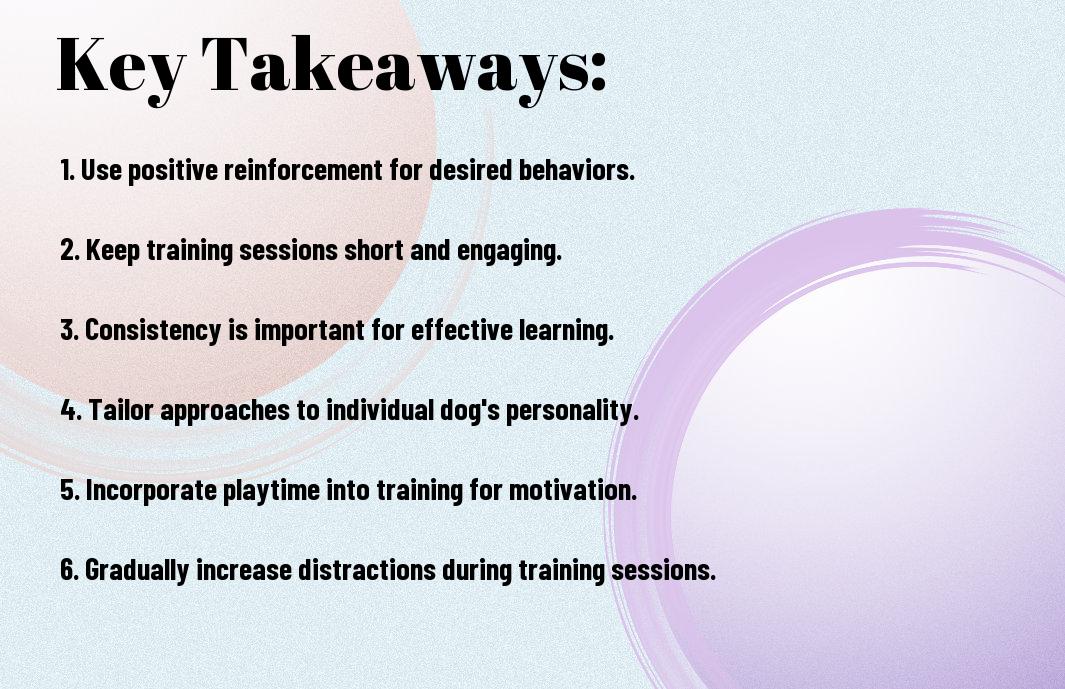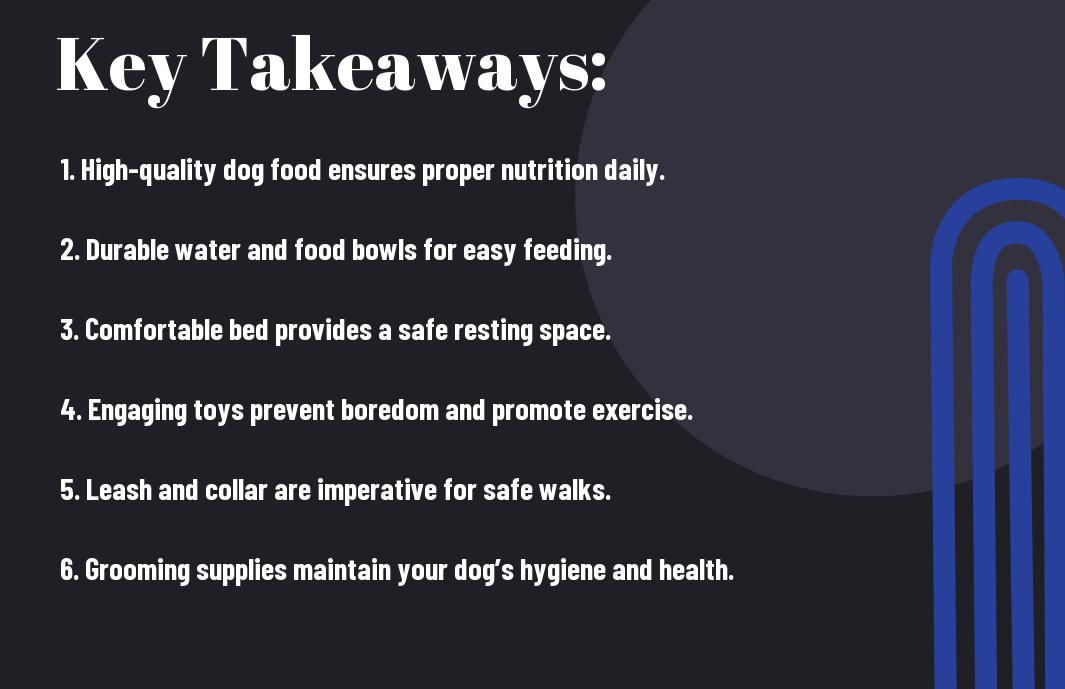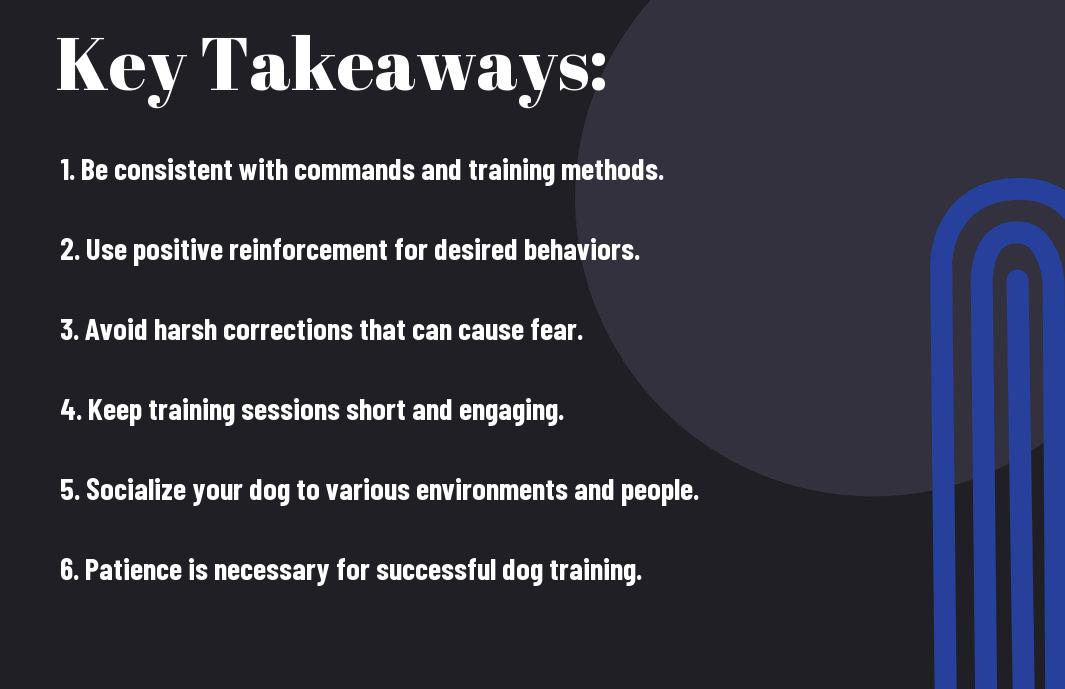It’s necessary to establish effective training and behavior management techniques to ensure a harmonious relationship with your dog. Understanding your pet’s needs and instincts will empower you to create a well-behaved companion. In this blog post, you’ll discover proven strategies that you can apply daily to foster positive behavior and strengthen the bond with your furry friend. Whether you’re a new dog owner or looking to refine your training approach, these tips will provide you with the tools necessary for success.


Understanding Canine Behavior
To effectively manage and train your dog, it is vital to have a solid understanding of canine behavior. By grasping the underlying factors that shape your dog’s actions and reactions, you can tailor your training approaches and create a harmonious living environment. Dogs communicate primarily through body language, vocalizations, and social interactions, which means that being attuned to these signals will help you better understand what your dog is communicating to you.
Factors Influencing Dog Behavior
Factors influencing dog behavior are diverse and can range from genetics to environment. Each dog is unique, and the interplay between these factors plays a significant role in shaping your dog’s personality and behaviors. Key influences include:
- Breed characteristics
- Age and developmental stage
- Socialization experiences
- Training history
- Health and well-being
This comprehensive knowledge will help you anticipate challenges and cater your training strategies to better suit your dog’s needs.
Common Behavioral Issues
Issues with dog behavior can range from mild to severe, and recognizing them early on can be pivotal in addressing them effectively. Common behavioral issues include excessive barking, separation anxiety, aggression towards people or other animals, and destructive chewing or digging. These problems can stem from a variety of factors, often intertwined, making it vital to take a holistic approach to understand their roots.
With awareness of these common behavioral issues, you can implement effective training strategies to rectify them. A proactive approach to training, combined with positive reinforcement, can help mitigate these issues and foster a more balanced relationship with your dog. By identifying the triggers and addressing them accordingly, you set the stage for long-term behavior improvement, enriching both your and your dog’s quality of life.
The Principles of Dog Training
Unlike common misconceptions, effective dog training is grounded in scientific principles and psychology. Understanding these principles can empower you to train your dog more effectively, creating a harmonious relationship between you and your pet. When you apply the right strategies, you position yourself not just as a trainer but as a leader in your dog’s life, which is vital for successful training outcomes.
The Science of Learning
Learning is a complex process that occurs both in humans and animals. Dogs learn through interactions with their environment, and these interactions can be influenced by rewards and consequences. Positive reinforcement, which rewards your dog for desired behavior, is one of the most effective methods because it builds a connection between the action and a favorable outcome. When you reward your dog, you encourage them to repeat that behavior, which helps solidify their learning.
Moreover, understanding the concept of operant conditioning can further enhance your training methods. This framework describes how behaviors can be strengthened or weakened through reinforcement or punishment. By focusing on positive reinforcement while minimizing negative reactions, you create a safe space for your dog to learn. This approach not only fosters trust but also encourages your dog to behave in a manner that aligns with your training goals.
Training Techniques
With the right training techniques, you can effectively shape your dog’s behavior and responses. Techniques such as clicker training, lure and reward, and desensitization are popular methods that cater to various aspects of canine behavior. Clicker training utilizes a sound to mark desired behaviors, making it clear to your dog what action is being rewarded. Lure and reward methods guide your dog into performing a task through the use of treats, while desensitization helps your dog become accustomed to stimuli that may cause anxiety.
Techniques must be consistent and patient to yield the best results. Incorporating varied strategies as appropriate can keep training sessions engaging for your dog. As you explore different methods, pay close attention to your dog’s responses and adjust your approaches as needed. This flexibility will enhance your training effectiveness, ensuring your dog feels motivated and eager to learn.
Developing a Training Plan
Not every dog is the same, and neither are their training needs. Before you begin implementing any training methods, it is imperative to assess your dog’s individual needs. Factors such as age, breed, temperament, and previous training experience will all play a role in determining the best approach for you and your furry friend.
Assessing Your Dog’s Needs
Dogs exhibit a wide range of behaviors and personalities, making it vital for you to understand what drives your dog. Some dogs might be more excitable or anxious, requiring different techniques for effective training. Taking time to observe your dog’s behaviors in various situations will help you set a baseline from which to work. This assessment will not only enable you to understand what areas require the most attention but also provide insight into how your dog learns best.
Setting Realistic Goals
Goals should be achievable and tailored to your dog’s specific needs. You should aim for short-term objectives that can be gradually built upon over time. For example, if your dog struggles with basic commands, it’s wise to start with one command at a time rather than overwhelming your pet with multiple tasks. By breaking down your training into manageable segments, you maintain both your dog’s interest and focus, leading to a more productive training experience.
Goals that are measurable can help keep you motivated and track progress. Ask yourself what you want to achieve with your dog in the short and long term. Whether it’s mastering basic commands, improving socialization with other dogs, or correcting undesirable behaviors, setting specific, measurable goals will help you maintain a clear focus while training.
Creating a Training Schedule
On your journey to develop an effective training plan, crafting a training schedule is key. Routine and consistency are highly beneficial for dogs as they instill a sense of security and predictability. By allocating specific days and times for training sessions, you make it easier for your dog to understand what is expected of them, while also reinforcing your leadership role.
Consider your own schedule when determining the times that work best for training. Short but frequent sessions often yield better results than longer, less frequent training periods. This approach enables your dog to remain engaged without losing focus, helping to form positive connections between commands and actions.
Understanding the importance of consistency in your training schedule will elevate the effectiveness of your efforts. Regular training not only promotes better retention of commands but also strengthens the bond between you and your dog. Whether you train daily or a few times a week, ensure the schedule suits both your lifestyle and your dog’s needs for optimal results.
Socialization Strategies
Importance of Socialization
Many dog owners underestimate the importance of socializing their pets. Socialization helps your dog develop confidence, reduces anxiety, and ensures they react positively to new experiences. When dogs are exposed to a variety of people, animals, and environments during their formative weeks, they learn to navigate the world safely and comfortably. A well-socialized dog is less likely to exhibit fear-based behaviors, aggression, or excessive barking, making outings more enjoyable for both you and your pet.
Moreover, socialization is beneficial for both physical and mental stimulation. Interacting with other dogs and people enhances your dog’s social skills and can help prevent boredom, which often leads to destructive behaviors. By prioritizing socialization, you are setting your dog up for a happier and more harmonious life in your home, community, and beyond.
Safe Socialization Techniques
Strategies to encourage socialization should always prioritize safety and comfort for your dog. Start by introducing your pet to controlled environments, such as puppy training classes or dog parks with friendly, well-mannered dogs. These spaces provide opportunities for interaction while ensuring that your dog is surrounded by positive experiences. Always supervise encounters to prevent overwhelming your dog, and be mindful of their body language—if you notice signs of stress, it’s best to back off and try again later.
Among the techniques that promote effective socialization, gradual exposure and positive reinforcement play an imperative role. Begin with low-pressure situations, such as walking your dog near other dogs from a distance. Use treats, praise, and toys to create positive associations with new encounters. As your dog becomes more comfortable, gradually reduce the distance and increase the complexity of the situations you expose them to. This method not only builds confidence but also strengthens your bond with your pet.
Considering your dog’s unique personality and past experiences will help you tailor your socialization efforts. Some dogs might flourish in busy environments, whereas others may prefer quieter settings where they can adjust at their own pace. Keep in mind that consistency is key—regular socialization sessions will reinforce the positive experiences and encourage your dog to embrace new encounters without fear.
Exposing Dogs to Various Environments
Across different environments, the socialization process should involve exposing your dog to a variety of settings, sounds, and sights. Whether it’s bustling streets, crowded parks, or pet-friendly cafés, each location presents an opportunity for your dog to learn and adjust. Introducing your dog to different environments helps them become well-rounded and adaptable, reducing the chance of fear or aggression in future situations. Make a list of various public places you can expose your dog to, gradually introducing them to each environment to minimize stress.
In fact, the more diverse the experiences you provide for your dog, the more confident they will become. It’s valuable to include exposure to different types of people, including children, seniors, and individuals in uniforms, as well as various animals. The goal is to normalize these encounters so that your dog can respond appropriately and comfortably. Always ensure that these experiences are positive and rewarding, as positive reinforcement will help solidify the desired behavior and ease your dog’s transition into various scenarios.

Managing Behavioral Issues
Once again, it’s vital to address behavioral issues in dogs with care and understanding. Dogs, like people, can develop habits and behaviors that may be problematic or even harmful. By employing effective strategies tailored to your dog’s unique needs, you can help create a positive environment for both your pet and yourself. Recognizing potential issues early will enable you to implement solutions that foster good behavior and strengthen your bond with your dog.
Approach to Aggression Management
On the topic of aggression, managing such behavior in dogs requires patience and a systematic approach. The first step is to identify the triggers that lead to aggressive behavior. These may include fear, territorial instincts, or frustration. Once you have pinpointed the underlying causes, you can begin to work on modifying your dog’s response through positive reinforcement techniques. Fostering a calm environment while gradually desensitizing your dog to the triggers can facilitate a more peaceful interaction.
Additionally, seeking professional guidance from a certified dog trainer or behavioral specialist can provide valuable insights tailored to your dog’s specific situation. They can help you develop a customized training plan that incorporates consistent commands, boundaries, and rewarding positive behavior. The ultimate goal should be to help your dog feel secure and confident, minimizing feelings that might lead to aggression.
Techniques for Reducing Anxiety
Techniques for reducing anxiety in your dog require a multifaceted approach that can greatly improve their overall demeanor. Start by creating a safe space where your dog can retreat when feeling overwhelmed. This space should be comfortable and free from disturbances. Additionally, engaging in regular physical exercise can have a significant positive impact on your dog’s mental health, as it helps to relieve built-up tension and channel energy constructively.
Another effective technique is to incorporate training exercises that promote focus and calmness. Activities like obedience training or engaging in interactive games can redirect anxious energy into productive behaviors. Consistency is key, so make sure to provide frequent reinforcement and praise when your dog exhibits calm behavior. Over time, the combination of a secure environment, structured exercise, and positive training experiences will help alleviate anxiety.
Behavioral modifications that you implement can significantly reduce your dog’s anxiety levels. However, sometimes more drastic measures, such as anxiety wraps or calming supplements, may be necessary for particularly anxious dogs. Consulting with a veterinarian can provide you with options tailored to your dog’s specific needs, ensuring their mental well-being is prioritized.
Redirecting Destructive Behaviors
With destructive behaviors, it is important to understand what leads your dog to engage in such actions. Dogs often resort to chewing or digging out of boredom, anxiety, or even excess energy. Redirecting these behaviors can be achieved by ensuring your dog has plenty of stimulating activities. Providing a variety of toys, engaging in regular play sessions, and incorporating puzzle toys can help keep your dog entertained and prevent them from seeking their own forms of amusement, which may lead to destruction.
In addition to offering alternative activities, establishing a clear set of rules for permissible behavior will further aid in redirecting destructiveness. Whenever your dog starts to engage in a destructive activity, such as chewing on furniture, calmly redirect them to a suitable toy or activity. Continuous reinforcement of positive behaviors with praise and treats when they choose the correct action will help solidify new habits, allowing your dog to find joy in appropriate play and interaction.
Reducing destructive behaviors involves engaging your dog in more productive and enjoyable alternatives. By closely monitoring their activities and providing consistent guidance, you can effectively highlight acceptable behaviors, which will naturally diminish the urge to act out destructively. This process may take time and patience, but with persistence, you will see significant improvements in your dog’s behavior.
Maintaining Consistency and Accountability
Keep in mind that a consistent approach to training is key to facilitating your dog’s understanding of expected behaviors. When you consistently enforce rules and commands, your dog learns to associate specific cues with actions. This predictable environment helps to solidify their training, making it easier for them to perform as expected. Variability in your responses can lead to confusion, which can subsequently result in unwanted behaviors. Thus, it is vital that you apply the same commands, rewards, and consequences in a uniform manner throughout your training sessions.
Importance of Consistency in Training
Consistency in training builds a strong foundation for your dog’s behavioral development. Every interaction you have with your dog can be viewed as a teaching moment, and consistency helps reinforce learning. If you give mixed signals or change the rules often, your dog will struggle to understand what you want from them. This could hinder their progress and create frustration for both of you. By maintaining a steady approach, you not only enhance your dog’s learning experience but also strengthen your bond as a team.
Involving Family Members in Training
Against a backdrop of mixed signals, training can become troublesome if multiple family members do not share a unified approach. Engaging all members of your household in the training process ensures that everyone understands the commands and guidelines you are teaching your dog. This collective effort minimizes inconsistencies and allows your dog to receive clearer communication. It’s beneficial to discuss and agree on specific training techniques, commands, and responses to ensure every person is on the same page.
The larger the training team, the more uniform the dog’s training experience will be. By involving family members, you not only distribute the training responsibilities, but also create a stronger pack mentality within your home. Each member can offer reinforcement and encouragement, making it easier for your dog to adopt the desired behaviors. When your dog senses that everyone in your household is reinforcing the same lessons and commands, they are more likely to grasp what is expected of them.
Tracking Progress and Celebrating Successes
Around your training journey, tracking your dog’s progress is an effective way to maintain accountability. Keeping a training journal can help you reflect on what works and what needs adjustment. This log will serve as a record of your dog’s achievements and challenges, ultimately guiding you in future training sessions. By documenting milestones, you can assess your dog’s learning curve and recognize patterns in their behavior, which can lead to more effective training strategies.
Maintaining a positive outlook and celebrating successes—no matter how small—can greatly boost your dog’s confidence and motivation. When you recognize and reward your dog for their progress, you create an encouraging atmosphere that fosters further learning. Small treats, a pat on the back, or enthusiastic praise can make a significant difference in your dog’s enthusiasm for training. These celebrations not only reinforce desired behaviors but also strengthen your relationship with your dog, making for a more enjoyable training experience for both of you.
Summing up
With these considerations, you can create a more harmonious relationship with your dog through effective training and behavior management strategies. Understanding your dog’s unique personality and needs, combined with implementing positive reinforcement techniques, will lead to a more receptive and well-behaved pet. Consistency in your training approach, along with patience and clarity in your commands, is key to reinforcing the desired behaviors and addressing any issues that may arise. By setting realistic expectations, you empower yourself to facilitate a smoother training process.
Additionally, integrating regular socialization, mental stimulation, and physical exercise into your dog’s routine not only aids in behavior management but also promotes overall well-being. Engaging with your dog through various activities builds trust and strengthens your bond, making it easier for you to guide them through their training journey. Adapting your strategies as needed will help you navigate the complexities of canine behavior, ensuring a fulfilling partnership between you and your furry companion.
FAQ
Q: What are some effective training methods for teaching basic commands to dogs?
A: There are several effective methods for teaching basic commands to dogs, including positive reinforcement, clicker training, and consistency. Positive reinforcement involves rewarding your dog with treats or praise when they successfully perform a command such as sit, stay, or come. Clicker training pairs a sound with a reward, helping dogs associate the click with positive behavior. Consistency is important; using the same commands and cues will help your dog understand what is expected of them. Training sessions should be kept short and engaging, aiming for several brief sessions rather than one long session to maintain the dog’s interest and focus.
Q: How can I manage my dog’s behavioral issues effectively?
A: Managing behavioral issues in dogs requires a clear understanding of the root causes and employing the right strategies. Identifying triggers for behaviors such as barking, chewing, or aggression can help. Techniques such as redirecting attention, providing adequate exercise, and creating a structured environment can alleviate many issues. For example, if your dog barks at passersby, consider redirecting their focus towards a toy or command when they start barking. Also, ensure your dog receives enough physical and mental stimulation, as boredom can lead to unwanted behaviors. If issues persist, consulting a professional trainer or behaviorist may provide additional insights and strategies tailored to your dog.
Q: How can socialization play a role in training and behavior management?
A: Socialization is a vital aspect of training that can significantly influence a dog’s behavior in various settings. Exposing puppies to different environments, people, and other animals can help them develop confidence and reduce fear-based behaviors as they grow older. Proper socialization helps prevent issues like aggression or excessive fear when encountering new experiences. Engaging in controlled playdates, group obedience classes, and outings to pet-friendly places are excellent ways to facilitate socialization. It’s important to make these experiences positive and rewarding to ensure your dog associates new encounters with good experiences, leading to better-behaved and more well-adjusted dogs.










